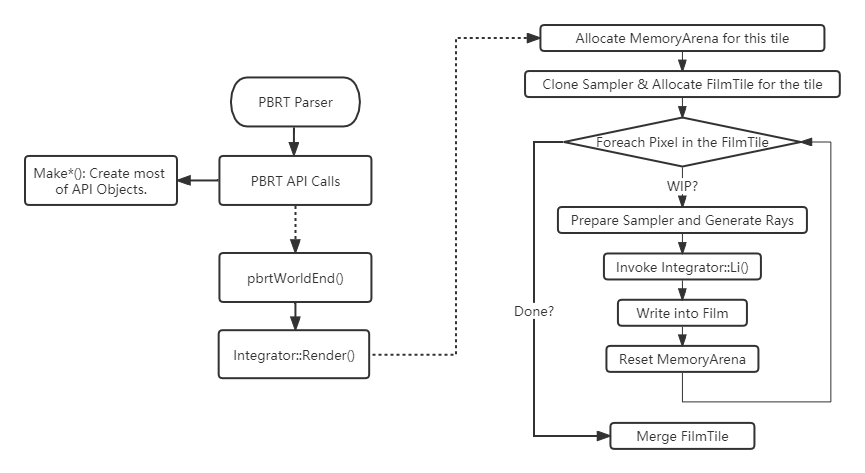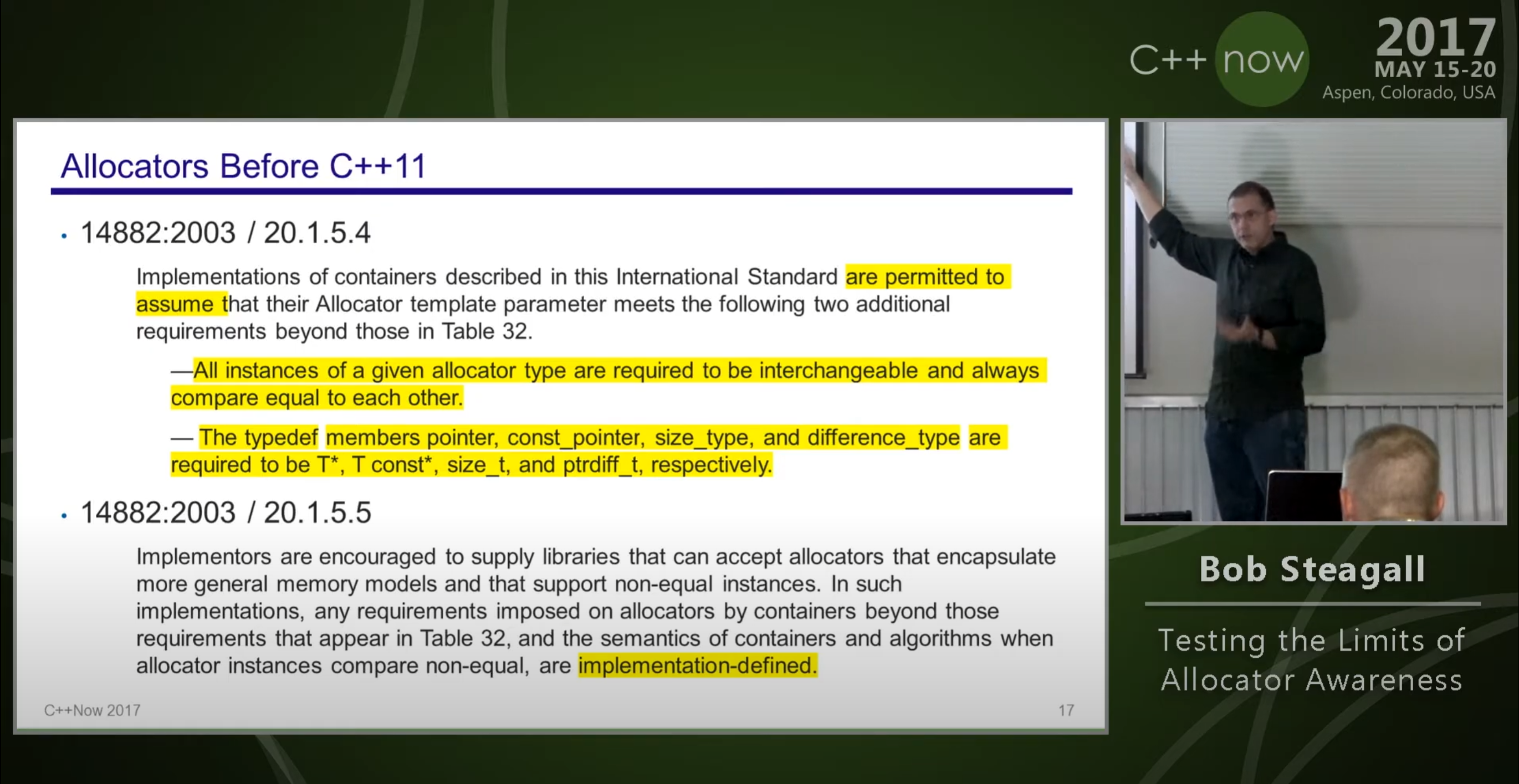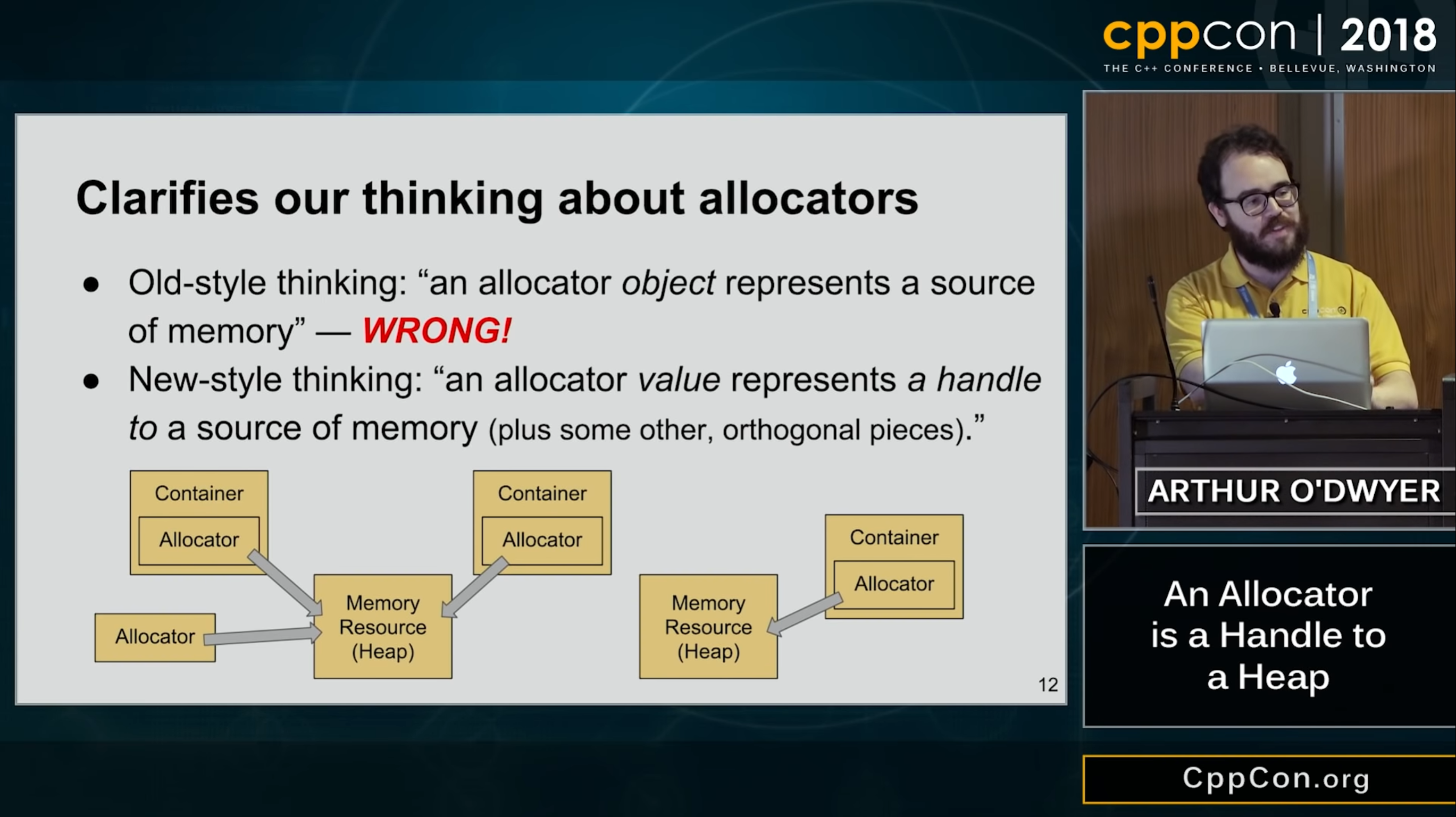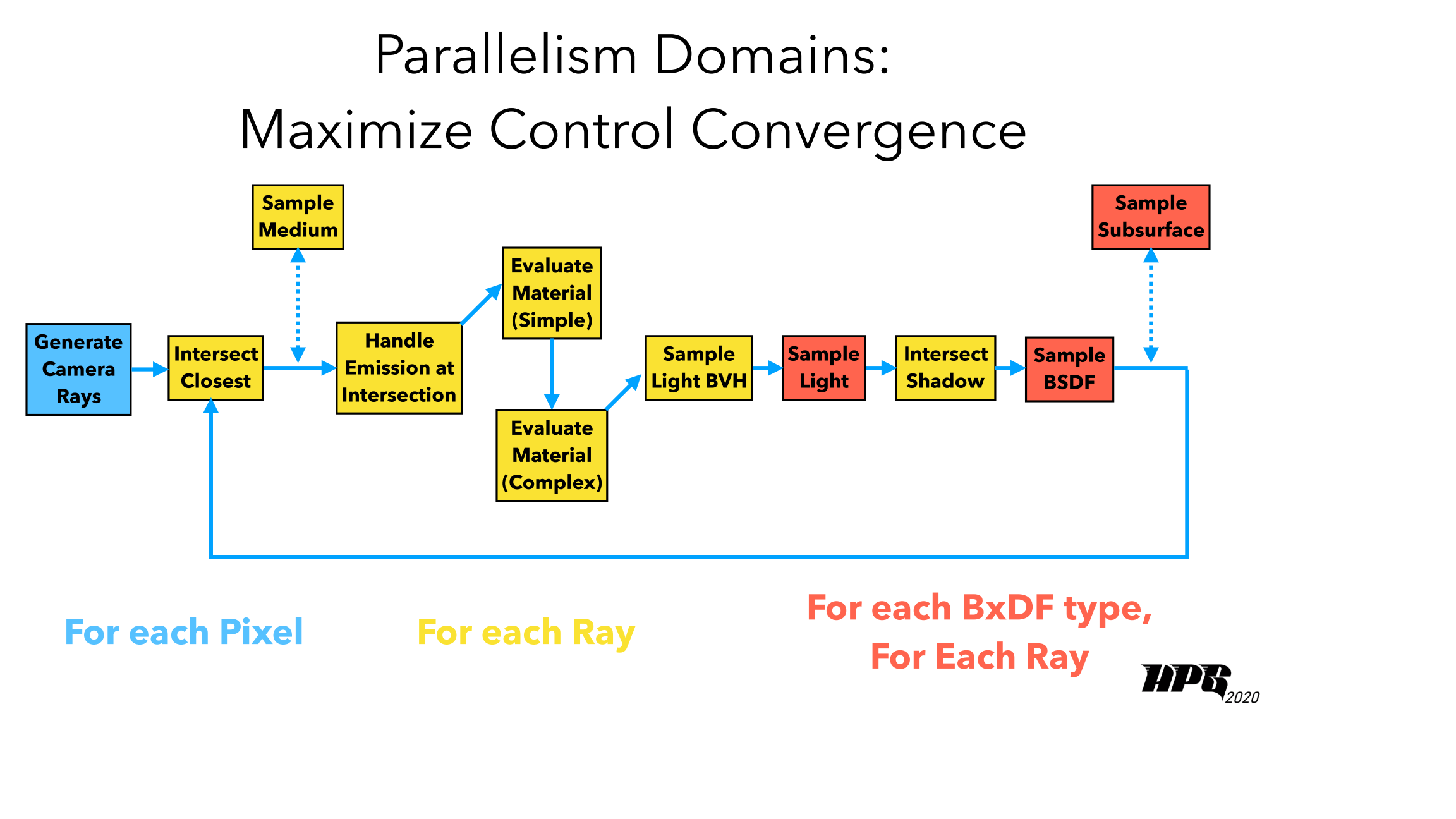pbrt's Target Audience: software developers in industry
- Book branch
- follow the textbook.
- texcache branch
- texture cache implementation.
- master branch
- C++ changes (towards practical usage).
- many-light sampling, practical fiber shading model etc.
pbrt Towards Production Changes
- Changes between pbrt-v3 and pbrt-v4:
- Rendering Algorithms: Spectral Rendering, Modern Volumetric Scattering, More BxDFs, Measured and Layered BSDFs, Many-light Sampling, Blue-noise Sobol Sampler.
- PhysLights from Weta Digital.
- VFX production workflow to reconstruct SPD of a real shot and perform rendering in physical units.
Image courtesy of Langlands and Fascione 2020
pbrt Towards Production Changes
- Changes between pbrt-v3 and pbrt-v4:
- Rendering Algorithms: Spectral Rendering, Modern Volumetric Scattering, More BxDFs, Measured and Layered BSDFs, Many-light Sampling, Blue-noise Sobol Sampler.
- PhysLights from Weta Digital.
- RTX-Accelerated GPU Rendering and Wavefront Path Tracer.
- GBufferFilm/AOVs output.
- ptex from Disney.
How Far is pbrt from Production?
- Performance over Clarity
- Think about SSE/ISPC code.
- ASWF Ecosystem: OpenColorIO, OpenVDB, OSL, MaterialX, etc.
- Subdivision (OpenSubdiv) and Displacement mapping*.
- Open problems in production for BDPT.
- On-the-fly subdivision/Micropolygon Preprocessing (Manuka).
- DCC Plugins or OpenUSD/Hydra Delegate.
- Textures as programs: OpenShadingLanguage/MDL.
How Far is pbrt from Production?
- Nested Volumes.
- AOV/LPE.
- Out-of-core Rendering*.
- (Multi-)C/G/XPU Rendering.
- Denoising.
- Statistics/Profiling.
pbrt with Moana Island?!

Image courtesty of Matt Pharr's blog Swallowing the elephant.
Outline
- Why pbrt?
- Overview of pbrt's architecture
- Porting pbrt to GPU, how?
- Overview
- How to make "core" runnable on GPU?
- What about data structures/libraries?
- How to coordinate with heterogeneous memory model?
- What about virtual functions?
- Launching GPU kernels?
- Recap
pbrt's Execution Flow*

*Almost the same for pbrt-v3 and pbrt-v4.
pbrt-v3: Source Group
| Directory: src/ | Base Class |
|---|---|
| accelerators | Aggregate |
| cameras | Camera |
| filters | Filter |
| integrators | Integrator |
| lights | Light |
| materials | Material |
| media | Media |
| samplers | Sampler |
| shapes | Shape |
| textures | Texture |
| core | Base class Utils |
| ext | External lib |
| main | pbrt CLI |
| tests | Unit tests |
| tools | Converters |
pbrt-v4: Source Group
| Directory | Base Class |
|---|---|
| ./src/pbrt | Derived Classes + Tests + pbrt CLI |
| ./src/pbrt/cpu | CPU Aggregates + Renderer + Integrators |
| ./src/pbrt/gpu | GPU Aggregates(OptiX) + Memory |
| ./src/pbrt/wavefront | Wavefront Integrator |
| core->./src/pbrt/base | Base classes |
| core->./src/pbrt/utils | Utilities |
| ext->./ext | External lib |
| tools->./src/pbrt/cmd | Converters |
Outline
- Why pbrt?
- Overview of pbrt's architecture
- Porting pbrt to GPU, how?
- Overview
- How to make "core" runnable on GPU?
- What about data structures/libraries?
- How to coordinate with heterogeneous memory model?
- What about virtual functions?
- Launching GPU kernels?
- Recap
How to Port pbrt to GPU?
Before diving into pbrt-v4's GPU implementation, consider:
- How to make "core" runnable on GPU?
- How to deal with data structures/libaries?
- STL implementation.
- How to coordinate with heterogeneous memory model?
- malloc/new on CPU cannot pass to GPU*
- Linux HMM (Heterogeneous Memory Management).
- Malloc/new in kernel is super slow.
- malloc/new on CPU cannot pass to GPU*
How to Port pbrt to GPU?
Before diving into pbrt-v4's GPU implementation, consider:
- How to coordinate with heterogeneous memory model?
- (SOA) Data layouts for coalescing memory access.
- Different architecture for CPU and GPU.
- ......
Outline
- Why pbrt?
- Overview of pbrt's architecture
- Porting pbrt to GPU, how?
- Overview
- How to make "core" runnable on GPU?
- What about data structures/libraries?
- How to coordinate with heterogeneous memory model?
- What about virtual functions?
- Launching GPU kernels?
- Recap
How to make "core" runnable on GPU?
Recall:
__device__== called by ==>__global__/__kernel____host__== called by ==> Host__global__== called by ==> Host but invoked on device, cannot be member functions.
pbrt Annotations:
PBRT_CPU_GPUmaps to__host__ __device__PBRT_GPUmaps to__device__?maps to__global__
class BSDF {
public:
// CPU Only.
BSDF() = default;
// CPU && GPU.
PBRT_CPU_GPU
BSDF(Normal3f ns, Vector3f dpdus, BxDF bxdf)
: bxdf(bxdf), shadingFrame(Frame::FromXZ(Normalize(dpdus), Vector3f(ns))) {}
PBRT_CPU_GPU
operator bool() const { return (bool)bxdf; }
PBRT_CPU_GPU
BxDFFlags Flags() const { return bxdf.Flags(); }
PBRT_CPU_GPU
Vector3f RenderToLocal(Vector3f v) const { return shadingFrame.ToLocal(v); }
PBRT_CPU_GPU
Vector3f LocalToRender(Vector3f v) const { return shadingFrame.FromLocal(v); }
}
Mixing CPU && GPU code in one place.
Outline
- Why pbrt?
- Overview of pbrt's architecture
- Porting pbrt to GPU, how?
- Overview
- How to make "core" runnable on GPU?
- What about data structures/libraries?
- How to coordinate with heterogeneous memory model?
- What about virtual functions?
- Launching GPU kernels?
- Recap
What about Data Structures/Libraries?
STL: std::vector/array/optional on GPU?
- NVCC:
expt-relaxed-constexprto enable constexpr__host__functions to be called in__device__(or the other way around)*.- constexpr <algorithm> for std::max (C++14), std::max_element (C++17) etc.
- constexpr <functional> std::plus<T> etc.
- constexpr std::array.
*<cmath> functions within STL are a bit different.
*std::initializer_list is a bit different. Refer to I.4.20.2.
What about Data Structures/Libraries?
STL: std::vector/array/optional on GPU?
- NVCC:
expt-relaxed-constexprto enable constexpr__host__functions to be called in__device__(or the other way around). - (pbrt-v4) Reinvent the wheels! pstd::array, pstd::vector etc.
template <typename T, int N> PBRT_CPU_GPU
class array { iterator begin() { return values; }
public: PBRT_CPU_GPU
using value_type = T; iterator end() { return values + N; }
using iterator = value_type *; PBRT_CPU_GPU
using const_iterator = const value_type *; const_iterator begin() const { return values; }
using size_t = std::size_t; PBRT_CPU_GPU
const_iterator end() const { return values + N; }
array() = default;
PBRT_CPU_GPU
/*--no-host-device-initializer-list.*/ size_t size() const { return N; }
PBRT_CPU_GPU
array(std::initializer_list<T> v) { PBRT_CPU_GPU
size_t i = 0; T &operator[](size_t i) { return values[i]; }
for (const T &val : v)
values[i++] = val; PBRT_CPU_GPU
} T *data() { return values; }
...
PBRT_CPU_GPU
void fill(const T &v) { private:
for (int i = 0; i < N; ++i) T values[N] = {};
values[i] = v; }
}
What about Data Structures/Libraries?
STL: std::vector/array/optional on GPU?
- NVCC:
expt-relaxed-constexprto enable constexpr__host__functions to be called in__device__(or the other way around). - (pbrt) Reinventing the wheels*! pstd::array, pstd::vector etc.
- External libraries: libcu++, thrust etc.
*These containers are redesigned to be compatible with polymorphic_allocator.
libcu++, thrust
- Thrust: Parallel STL library for CUDA C++.
- Algorithms w/ iterators: sorting, searching, copying etc.
- Containers: host_vector, device_vector and universal_vector (since V1.12.0).
- Utilities: pair, tuple and type_traits.
- Memory allocators.
- libcu++
- Complementary to Thrust: atomics/synchronization and utilities.
- Support array since V1.8.0 (yet to be included in CUDA SDK).
Example: cuda::std::array instead of pstd::array
template<typename ArrayType, size_t ArraySize>
__global__ void libcuTest(cuda::std::array<ArrayType, ArraySize> x,
cuda::std::array<ArrayType, ArraySize> y) {
for (int i = 0; i < ArraySize; i++) {
printf("--: %d\n", std::plus<ArrayType>()(x[i], y[i]));
}
}
int main(){
cuda::std::array<int, 5> arrayX;
arrayX.fill(10);
cuda::std::array<int, 5> arrayY;
arrayY.fill(20);
libcuTest<decltype(arrayX)::value_type, arrayX.size()> <<<1, 1>>> (arrayX, arrayY);
return 0;
}
What about Data Structures/Libraries?
Lessons learned:
- No perfect solutions (yet).
expt-relaxed-constexprcould help, but not too much...- NVIDIA's thrust and libcu++ are useful, but no
optionalsupport so far (on the road). - Write your own implementations inspired by Google's abseil, Meta's folly etc.
Outline
- Why pbrt?
- Overview of pbrt's architecture
- Porting pbrt to GPU, how?
- Overview
- How to make "core" runnable on GPU?
- What about data structures/libraries?
- How to coordinate with heterogeneous memory model?
- What about virtual functions?
- Launching GPU kernels?
- Recap
How to coordinate with heterogeneous memory model?
Recall memory allocation at host side:
new/malloc*.ThreadPool,MemoryArenaetc.alloca().
How to coordinate with heterogeneous memory model?
Recall memory allocation at device side:
- Linear memory (UVA for 64-bit application, >= CC 2.0 devices).
- Device memory:
cudaMalloc{Pitch|3D}. - Pageable host memory w/ transfer:
new/malloc+cudaMemcpy{2D|3D}. - Pinned host memory w/ transfer:
cudaHostAlloc(cudaHostAllocDefault). - Zero-copy memory:
cudaHostAlloc(cudaHostAllocMapped) - Unified memory:
cudaMallocManaged().
- Device memory:
- CUDA arrays for texture fetching.
Where are the memory allocations happening?
Where are the memory allocations happening?
- Local memory/Stack variables are allocated by compiler.
- No need to worry about.
- No need to worry about.
- Amost all dynamic allocations happen before rendering.
- Allocate on the host and copy to the device.
- Avoid dynamic memory allocations on the fly.
- Though you can new/malloc/alloca in device code.
- Special memory allocations may be available, e.g.
ALLOCA().
Using allocators to allocate memory for heterogeneous memory resources.
We need to abstract different types of memory allocations.
std::allocator<T>is useful but...- Before C++11, allocator must be stateless.
 CppNow 2017.
CppNow 2017.
*Using allocators to allocate memory for heterogeneous memory resources.
We need to abstract different types of memory allocations.
std::allocator<T>helps but it is one of the most mysterious parts of namespace std, as well as one of the more flexible parts.- Before C++11, allocator must be stateless.
- Since C++11, allocator could be stateful leveraging
allocator_traitsbut it is tremendously difficult to implement.- Pointer traits (for fancy/synthetic pointer)
- Template rebinding (for containers such as linked list).
- Propagation for copy, move, swap (POCCA/POCMA/POCS).
- Deep propagation (
std::scoped_allocator_adaptor).
Using allocators to allocate memory for heterogeneous memory resources.
We need to abstract different types of memory allocations.
std::pmr::polymorphic_allocatorsupports a simpler allocator model for library authors and users since C++17.
pbrt-v4 reinvented the wheels though in pstd namespace:
namespace pstd{
class memory_resource {
public:
virtual ~memory_resource();
void *allocate(size_t bytes, size_t alignment = max_align) {
return do_allocate(bytes, alignment);
}
void deallocate(void *p, size_t bytes, size_t alignment = max_align) {
return do_deallocate(p, bytes, alignment);
}
bool is_equal(const memory_resource &other) const noexcept {
return do_is_equal(other);
}
private:
virtual void *do_allocate(size_t bytes, size_t alignment) = 0;
virtual void do_deallocate(void *p, size_t bytes, size_t alignment) = 0;
virtual bool do_is_equal(const memory_resource &other) const noexcept = 0;
};
} // namespace pstd
pbrt-v4 uses unified memory* for CUDA memory resource.
class CUDAMemoryResource : public pstd::pmr::memory_resource {
void *do_allocate(size_t size, size_t alignment){
void *ptr;
CUDA_CHECK(cudaMallocManaged(&ptr, size));
CHECK_EQ(0, intptr_t(ptr) % alignment);
return ptr;
}
void do_deallocate(void *p, size_t bytes, size_t alignment){
CUDA_CHECK(cudaFree(p));
}
bool do_is_equal(const memory_resource &other) const noexcept {
return this == &other;
}
};
*Unified Memory: one single pointer for host and device access. No more cudaMemcpy() calls, CUDA runtime does this automatically for developers.
using Allocator = polymorphic_allocator<std::byte>;
template <class Tp = std::byte>
class polymorphic_allocator {
public:
using value_type = Tp;
polymorphic_allocator() noexcept { memoryResource = new_delete_resource(); }
polymorphic_allocator(memory_resource *r) : memoryResource(r) {}
memory_resource *resource() const { return memoryResource; }
// member functions
[[nodiscard]] Tp *allocate(size_t n) {
return static_cast<Tp *>(resource()->allocate(n * sizeof(Tp), alignof(Tp)));
}
void deallocate(Tp *p, size_t n) { resource()->deallocate(p, n); }
void *allocate_bytes(size_t nbytes, size_t alignment = alignof(max_align_t));
void deallocate_bytes(void *p, size_t nbytes,
size_t alignment = alignof(std::max_align_t));
template <class T>
T *allocate_object(size_t n = 1);
template <class T>
void deallocate_object(T *p, size_t n = 1);
template <class T, class... Args>
T *new_object(Args &&...args) {
// NOTE: this doesn't handle constructors that throw exceptions...
T *p = allocate_object<T>();
construct(p, std::forward<Args>(args)...);
return p;
}
template <class T>
void delete_object(T *p);
template <class T, class... Args>
void construct(T *p, Args &&...args) {
::new ((void *)p) T(std::forward<Args>(args)...);
}
template <class T>
void destroy(T *p) {
p->~T();
}
private:
memory_resource *memoryResource;
};
*FYI: Thrust has a bit different implementation that may benefit CUDA applications.
- The high-level idea is still the same as C++17.
- Opt-in type erasure for
memory_resourceimplementation as opposed to dynamic dispatch by default. - Better implementation for
(un)synchronized_pool_resource.- More tuning parameters for the pool.
- Bookkeeping memory allocation separated to avoid memory migration back and forth.
Reference:
Memory Resources in a Heterogeneous World at CppCon 2019.
Recall: Where are the memory allocations happening?
PointLight *PointLight::Create(const Transform &renderFromLight, Medium medium,
const ParameterDictionary ¶meters,
const RGBColorSpace *colorSpace, const FileLoc *loc,
Allocator alloc) {
Spectrum I = parameters.GetOneSpectrum("I", &colorSpace->illuminant,
SpectrumType::Illuminant, alloc);
Float sc = parameters.GetOneFloat("scale", 1);
Float phi_v = parameters.GetOneFloat("power", -1);
...
return alloc.new_object<PointLight>(finalRenderFromLight, medium, I, sc);
}
PointLight::Create() is neither PBRT_CPU_GPU nor PBRT_GPU! It could only be invoked on the CPU side; recall:
- Amost all dynamic allocations happen before rendering.
How is PointLight looks like really?
PointLight looks like really?This is what PointLight like in pbrt-v3:
class PointLight : public Light {
public:
PointLight(const Transform &LightToWorld,
const MediumInterface &mediumInterface, const Spectrum &I);
Spectrum Sample_Li(const Interaction &ref, const Point2f &u, Vector3f *wi,
Float *pdf, VisibilityTester *vis) const;
Spectrum Power() const;
Float Pdf_Li(const Interaction &, const Vector3f &) const;
Spectrum Sample_Le(const Point2f &u1, const Point2f &u2, Float time,
Ray *ray, Normal3f *nLight, Float *pdfPos,
Float *pdfDir) const;
void Pdf_Le(const Ray &, const Normal3f &, Float *pdfPos, Float *pdfDir) const;
private:
const Point3f pLight;
const Spectrum I;
};
Outline
- Why pbrt?
- Overview of pbrt's architecture
- Porting pbrt to GPU, how?
- Overview
- How to make "core" runnable on GPU?
- What about data structures/libraries?
- How to coordinate with heterogeneous memory model?
- What about virtual functions?
- Launching GPU kernels?
- Recap
This is what Light like in pbrt-v3:
class Light {
public:
virtual ~Light();
Light(int flags, const Transform &LightToWorld, const MediumInterface &mediumInterface, int nSamples = 1);
virtual Spectrum Sample_Li(const Interaction &ref, const Point2f &u, Vector3f *wi, Float *pdf,
VisibilityTester *vis) const = 0;
virtual Spectrum Power() const = 0;
virtual void Preprocess(const Scene &scene) {}
virtual Spectrum Le(const RayDifferential &r) const;
virtual Float Pdf_Li(const Interaction &ref, const Vector3f &wi) const = 0;
virtual Spectrum Sample_Le(const Point2f &u1, const Point2f &u2, Float time, Ray *ray,
Normal3f *nLight, Float *pdfPos, Float *pdfDir) const = 0;
virtual void Pdf_Le(const Ray &ray, const Normal3f &nLight, Float *pdfPos, Float *pdfDir) const = 0;
const int flags;
const int nSamples;
const MediumInterface mediumInterface;
protected:
const Transform LightToWorld, WorldToLight;
};
What about virtual functions?
CUDA C Programming Guide I.4.10.3:
It is not allowed to pass as an argument to a global function an object of a class with virtual functions.
If an object is created in host code, invoking a virtual function for that object in device code has undefined behavior.
If an object is created in device code, invoking a virtual function for that object in host code has undefined behavior.
This is incompatible with our paradigm: allocating object with virtual functions in the host and passed it to the device side.
What about virtual functions?
CUDA C Programming Guide I.4.10.3:
It is not allowed to pass as an argument to a global function an object of a class with virtual functions.
If an object is created in host code, invoking a virtual function for that object in device code has undefined behavior.
If an object is created in device code, invoking a virtual function for that object in host code has undefined behavior.*
*Caveat: Why? It is perfectly fine if an object is created in device code and you could invoke virtual dispatch in kernel.
What about virtual functions?
Virtual dispatch on GPU is not recommended anyway and we need some solutions.
What about virtual functions?
Possible solutions:
- No virtual and plain switch-case based on type (cycles, luxcore).
- Variant/TaggedUnion.
- cuda::std::variant is not yet implemented in libcu++ (#162).
- C++ Compile Time Polymorphism for Ray Tracing.
- CRTP Compile Time Polymorphism.
- TaggedPtr (pbrt-v4).
TaggedPtr
Stems from vtable hacks for rendering Disney's Moana island scene.
Each triangle in the scene carries an overhead of at least two vtable pointers: one for its Triangle and one for its SimplePrimitive. That’s 16 bytes. The Moana island scene has a total of 146,162,124 unique triangles, which adds up to almost 2.2 GB of highly-redundant vtable pointers. -- Swallowing the elephant (part 5) by Matt Pharr.
x86 CPUs today only use 48 bits of 64-bit addressing space for pointers.
See also: CUDA C Programming Guide 3.2.2. Device Memory.
pbrt-v4's TaggedPtr
Builds on Meta/Folly's DiscriminatedPtr, at taggedptr.h
template <typename... Ts>
class TaggedPointer {
public:
PBRT_CPU_GPU unsigned int Tag() const { return ((bits & tagMask) >> tagShift); }
PBRT_CPU_GPU void *ptr() { return reinterpret_cast<void *>(bits & ptrMask); }
...
private:
static constexpr int tagShift = 57;
static constexpr int tagBits = 64 - tagShift;
static constexpr uint64_t tagMask = ((1ull << tagBits) - 1) << tagShift;
static constexpr uint64_t ptrMask = ~tagMask;
uintptr_t bits = 0;
public:
template <typename F>
PBRT_CPU_GPU decltype(auto) Dispatch(F &&func) {
DCHECK(ptr());
using R = typename detail::ReturnType<F, Ts...>::type;
return detail::Dispatch<F, R, Ts...>(func, ptr(), Tag() - 1);
}
template <typename F>
decltype(auto) DispatchCPU(F &&func) {
DCHECK(ptr());
using R = typename detail::ReturnType<F, Ts...>::type;
return detail::DispatchCPU<F, R, Ts...>(func, ptr(), Tag() - 1);
}
}
*Note that there is a bug related to variadic template in their detail::Dispatch<>() implementation (See the next slide).
template <typename F, typename R, typename T0, typename T1, typename T2, typename T3,
typename T4, typename T5, typename T6, typename T7, typename... Ts>
auto DispatchCPU(F &&func, const void *ptr, int index) {
switch (index) {
case 0:
return func((const T0 *)ptr);
case 1:
return func((const T1 *)ptr);
...
default:
return DispatchCPU<F, R, Ts...>(func, ptr, index - 8);
}
}
- Note that parameter pack could contain zero parameter in which case we suffer from ambiguous function calls.
- Could be solved by
SFINAEso I opened a PR#253.
- Could be solved by
Replace virtuals with TaggedPtr: Step 1: Remove virtuals.
This is what Light base class like in pbrt-v4:
class Light : public TaggedPointer<PointLight, DistantLight, DiffuseAreaLight> {
public:
using TaggedPointer::TaggedPointer;
static Light Create(const std::string &name, const ParameterDictionary ¶meters,
const Transform &renderFromLight,
const CameraTransform &cameraTransform, Medium outsideMedium,
const FileLoc *loc, Allocator alloc);
PBRT_CPU_GPU inline LightType Type() const;
std::string ToString() const;
PBRT_CPU_GPU void PDF_Le(const Ray &ray, Float *pdfPos, Float *pdfDir) const;
...
};
PointLight inherits from LightBase:
class PointLight : public LightBase {
public:
PointLight(Transform renderFromLight, MediumInterface mediumInterface, Spectrum I, Float scale);
static PointLight *Create(const Transform &renderFromLight, Medium medium,
const ParameterDictionary ¶meters,
const RGBColorSpace *colorSpace, const FileLoc *loc,
Allocator alloc);
std::string ToString() const;
PBRT_CPU_GPU void PDF_Le(const Ray &, Float *pdfPos, Float *pdfDir) const;
...
private:
const DenselySampledSpectrum *I;
Float scale;
};
Replace virtuals with TaggedPtr: Step 2: Add "templated" Dispatch calls.
void Light::PDF_Le(const Ray &ray, Float *pdfPos, Float *pdfDir) const {
auto pdf = [&](auto ptr) { return ptr->PDF_Le(ray, pdfPos, pdfDir); };
return Dispatch(pdf);
}
SampledSpectrum Light::Phi(SampledWavelengths lambda) const {
auto phi = [&](auto ptr) { return ptr->Phi(lambda); };
return DispatchCPU(phi);
}
void Light::Preprocess(const Bounds3f &sceneBounds) {
auto preprocess = [&](auto ptr) { return ptr->Preprocess(sceneBounds); };
return DispatchCPU(preprocess);
}
class LightBase {
public:
LightBase(LightType type, const Transform &renderFromLight, const MediumInterface &mediumInterface);
PBRT_CPU_GPU LightType Type() const { return type; }
PBRT_CPU_GPU
SampledSpectrum L(Point3f p, Normal3f n, Point2f uv, Vector3f w,
const SampledWavelengths &lambda) const {
return SampledSpectrum(0.f);
}
PBRT_CPU_GPU
SampledSpectrum Le(const Ray &, const SampledWavelengths &) const {
return SampledSpectrum(0.f);
}
protected:
LightType type;
...
};
Replace virtuals with TaggedPtr.
Caveat/Problems:
Lightmust know all possible "Derived" light types.- No more virtual calls! But no more
overridechecks! Lightwas namedLightHandlebefore, which becomes an handle.Lightis a handle whilePointLightis not!- Weird
L()andLe()inLightBase.
- Some fields are not accessible from GPU, e.g.
std::string.
Example: Memory allocations for pointlights (pseudocode).
- Allocate memory for
PointLightvia polymorphic allocator:
PointLight* pPointLight = alloc.new_object<PointLight>(...);
- Obtain/Construct a
Light(Light handle in essence) fromPointLight:
Light pLightHandle{pPointLight};
- Use the
Lightin kernel to access data/tagged dispatch:
PBRT_CPU_GPU void LightSampling(...){
...
pstd::optional<LightLiSample> ls = pLightHandle.SampleLi(...); // Invoke tagged dispatch (runtime polymorphism).
if (!ls || !ls->L || ls->pdf == 0)
return;
...
}
Outline
- Why pbrt?
- Overview of pbrt's architecture
- Porting pbrt to GPU, how?
- Overview
- How to make "core" runnable on GPU?
- What about data structures/libraries?
- How to coordinate with heterogeneous memory model?
- What about virtual functions?
- Launching GPU kernels?
- Recap
Launching GPU kernels?
We have not seen __global__ functions so far but __device__ ...
- Who launches GPU kernels?
- Integrator/Renderer.
- How many kernels do we need? In other words, one megakernel or lots of spilt wavefront/microkernels?
- Trade-off launching costs and kernel efficiency.
- Generally, Megakernel Considered Harmful....
- But not always, Dr.Jit: A Just-In-Time Compiler for Differentiable Rendering.
- Trade-off launching costs and kernel efficiency.
Still, wavefront path tracing is used ubiquitously in production.
Why?
- GPU follows SIMT model:
- 32 threads* in a warp executing together.
- Concern about branch divergence.
- High-bandwidth, high-latency memory model.
- Need to expose enough parallelism with coherent memory access*.
- Instruction caches are tend to be smaller.
- A megakernel could run out of the instruction cache.
- Could hurt latency hiding and suffers from register pressure.
- A megakernel could run out of the instruction cache.
pbrt-v4: WavefrontPathIntegrator.
- Core kernel code could be shared across CPU & GPU w/ PBRT_CPU_GPU annotation.
WavefrontPathIntegratorlaunches GPU kernels for volumetric path tracing.- OptiX as an intersection device for hardware intersection.
- Ray generations, shading, filtering, film writing etc. as native CUDA kernels.
Launching GPU kernels: Implementation for non-queued kernels
template <typename F>
void ParallelFor(const char *description, int nItems, F &&func) {
if (Options->useGPU)
GPUParallelFor(description, nItems, func);
...
}
template <typename F>
__global__ void Kernel(F func, int nItems) {
int tid = blockIdx.x * blockDim.x + threadIdx.x;
func(tid); // func has a thread id.
}
template <typename F>
void GPUParallelFor(const char *description, int nItems, F func) {
auto kernel = &Kernel<F>; // Getting address of a global kernel in host.
int blockSize = GetBlockSize(description, kernel);
int gridSize = (nItems + blockSize - 1) / blockSize;
kernel<<<gridSize, blockSize>>>(func, nItems);
}
Launching GPU kernels: Implementation for non-queued kernels
template <typename ConcreteSampler>
void WavefrontPathIntegrator::GenerateCameraRays(int y0, int sampleIndex) {
RayQueue *rayQueue = CurrentRayQueue(0);
ParallelFor(
"Generate camera rays", maxQueueSize, PBRT_CPU_GPU_LAMBDA(int pixelIndex) {
// sampler is captured by value.
ConcreteSampler pixelSampler = *sampler.Cast<ConcreteSampler>();
CameraSample cameraSample = GetCameraSample(pixelSampler, pPixel, filter);
pstd::optional<CameraRay> cameraRay = camera.GenerateRay(cameraSample, lambda);
pixelSampleState.L[pixelIndex] = SampledSpectrum(0.f);
rayQueue->PushCameraRay(cameraRay->ray, lambda, pixelIndex);
...
});
}
GenerateCameraRays() will be executed in parallel on GPU!
Definition of PBRT_CPU_GPU_LAMBDA:
#define PBRT_CPU_GPU __host__ __device__
#ifdef PBRT_IS_WINDOWS
#define PBRT_CPU_GPU_LAMBDA(...) [ =, *this ] PBRT_CPU_GPU(__VA_ARGS__) mutable
#else
#define PBRT_CPU_GPU_LAMBDA(...) [=] PBRT_CPU_GPU(__VA_ARGS__)
#endif
Background information:
- CUDA device lambda is supported since CUDA 8.
- In CUDA 7.5, you can define device lambdas in host code and use them to instantiate global function templates. CUDA 8 now also supports host device lambdas in global template instantiations. Since the lambda is marked host device, it can be called from host code as well. This is very useful because it allows you to make a runtime decision whether to execute a lambda on the GPU or the CPU.
#define PBRT_CPU_GPU __host__ __device__
#ifdef PBRT_IS_WINDOWS
#define PBRT_CPU_GPU_LAMBDA(...) [ =, *this ] PBRT_CPU_GPU(__VA_ARGS__) mutable
#else
#define PBRT_CPU_GPU_LAMBDA(...) [=] PBRT_CPU_GPU(__VA_ARGS__)
#endif
Background information:
- Need to capture
*thisby value. (Why?*)- C++17 supports
*thiscapture mode.- Alternatively
[thisVal=*this]in C++14.
- Alternatively
- C++17 supports
*You cannot access host memory in device code in general.
Launching GPU kernels: Implementation for queued kernels
template <typename F, typename WorkItem>
void ForAllQueued(const char *desc, const WorkQueue<WorkItem> *q, int maxQueued, F &&func) {
// Launch GPU threads to process _q_ using _func_
GPUParallelFor(desc, maxQueued, [=] PBRT_GPU(int index) mutable {
func((*q)[index]);
});
}
template <typename F>
__global__ void Kernel(F func, int nItems) {
int tid = blockIdx.x * blockDim.x + threadIdx.x;
func(tid); // func has a thread id.
}
template <typename F>
void GPUParallelFor(const char *description, int nItems, F func) {
auto kernel = &Kernel<F>; // Getting address of a global kernel in host.
int blockSize = GetBlockSize(description, kernel);
int gridSize = (nItems + blockSize - 1) / blockSize;
kernel<<<gridSize, blockSize>>>(func, nItems);
}
Queued kernel example: HandleEscapedRays()
void WavefrontPathIntegrator::HandleEscapedRays() {
ForAllQueued(
"Handle escaped rays", escapedRayQueue, maxQueueSize,
PBRT_CPU_GPU_LAMBDA(const EscapedRayWorkItem w) {
SampledSpectrum L(0.f);
for (const auto &light : *infiniteLights) {
...Compute L...
}
L += pixelSampleState.L[w.pixelIndex]; // SOA
pixelSampleState.L[w.pixelIndex] = L;
});
}
Outline
- Why pbrt?
- Overview of pbrt's architecture
- Porting pbrt to GPU, how?
- Overview
- How to make "core" runnable on GPU?
- What about data structures/libraries?
- How to coordinate with heterogeneous memory model?
- What about virtual functions?
- Launching GPU kernels?
- Recap
Recap
- pbrt-v4 goodness (engineering perspective):
- One universal piece of code works on CPU & GPU.
- Modern C++17 w/ CUDA
- Host/Device lambda
- TaggedPtr for polymorphism
- Unified memory with polymorphic allocators
- "Stackless" material graph w/o SVM
- libcu++ atomics
- CUDA Runtime API
Recap
- pbrt-v4 weakness (engineering perspective):
- Integrator still needs to be specialized on GPU
- Only wavefront volumetric path tracing integrator yet
- Modern C++17 w/ CUDA but heavy template based
- Could be hard to use
- Additional compile time overhead
- Be aware of CPU & GPU programming model or segfault
- Integrator still needs to be specialized on GPU
Further Reading
CppCon at STL allocators:
- Memory Resources in a Heterogeneous World
- An Allocator is a Handle to a Heap
- Bringing Existing Code to CUDA Using constexpr and std::pmr
- Allocators: The Good Parts
- How to Write a Custom Allocator
- Getting Allocators out of Our Way
- Testing the Limits of Allocator Awareness
- An allocator model for std2
- Local ('Arena') Memory Allocators (part 1 of 2)
What is left to be covered about this talk?
- pbrt-v4 building (this is easy! :D)
- Unified memory in depth and memory alignment
- cuda texture
- Better cuda programming options: CUDA-API-Wrappers, kat etc.
- OptiX
- Material implementation
- procedural textures
- mix material
- containers.h implementations,
pstd::span,pstd::optional,pstd::tuple,WorkQueue,MultiQueueetc. - SOA
Acknowledgments
- Tzu Mao Li's UCSD CSE 272: Advanced Image Synthesis.
- Matt Pharr's blog and talks on pbrt-v4.
- Junchen Deng (Slongle).

